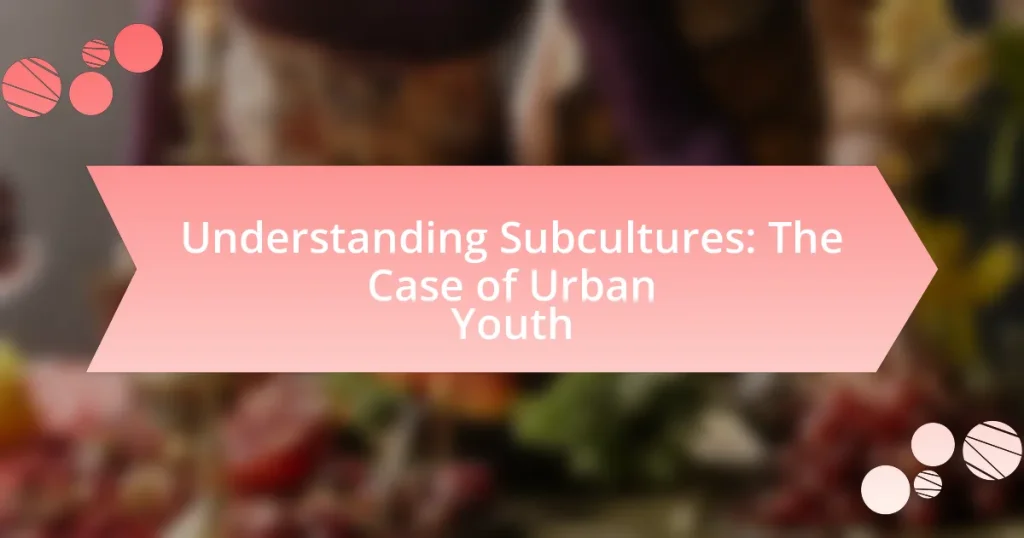Subcultures are defined as distinct cultural groups within a larger culture, characterized by unique values, norms, and practices that set them apart from mainstream society. This article explores the significance of urban youth subcultures, examining how they form in response to social and economic factors, and the role of peer influence in shaping identity. It highlights the psychological impacts of subculture affiliation, the characteristics that define these groups, and the challenges they face, including external perceptions and societal stereotypes. Additionally, the article discusses how urban youth subcultures can promote positive change in their communities and the importance of education and community programs in supporting these cultural expressions.

What are Subcultures and Why are They Important?
Subcultures are distinct cultural groups within a larger culture, characterized by unique values, norms, and practices that differentiate them from the mainstream. They are important because they provide a sense of identity and belonging for individuals, particularly among urban youth, who may feel marginalized by dominant societal norms. Research indicates that subcultures can foster creativity, social cohesion, and resilience, as seen in urban youth movements that promote social change and community engagement. For instance, the hip-hop subculture has significantly influenced music, fashion, and social activism, demonstrating the powerful role subcultures play in shaping cultural landscapes and addressing social issues.
How do subcultures form within urban youth communities?
Subcultures form within urban youth communities through shared experiences, interests, and identities that differentiate them from the mainstream culture. These groups often emerge in response to social, economic, and cultural factors, such as urbanization, socioeconomic disparities, and the quest for belonging. For instance, research indicates that youth in urban settings often seek to express their individuality and resist dominant cultural norms, leading to the formation of distinct subcultures like hip-hop, punk, or skateboarding communities. These subcultures provide a sense of identity and solidarity among members, reinforced by shared values, language, and styles, which are often influenced by local environments and peer interactions.
What social factors contribute to the emergence of urban youth subcultures?
Social factors contributing to the emergence of urban youth subcultures include socioeconomic status, peer influence, cultural diversity, and urbanization. Socioeconomic status affects access to resources and opportunities, leading youth to form subcultures as a means of identity and belonging in response to economic challenges. Peer influence plays a crucial role, as young individuals often seek acceptance and validation from their social groups, which can lead to the adoption of specific styles, behaviors, and values. Cultural diversity in urban areas fosters a mix of traditions and practices, allowing for the blending of influences that shape unique subcultures. Urbanization creates environments where youth can interact, share experiences, and develop distinct identities, often in reaction to the mainstream culture. These factors collectively drive the formation and evolution of urban youth subcultures.
How do peer influences shape the identity of urban youth subcultures?
Peer influences significantly shape the identity of urban youth subcultures by providing a framework for social norms, values, and behaviors that individuals adopt to fit in. These influences manifest through shared experiences, language, fashion, and music preferences, which collectively create a sense of belonging among peers. Research indicates that adolescents are particularly susceptible to peer pressure, with studies showing that 70% of youth report that their friends influence their choices in style and behavior (Brown et al., 2015, Journal of Youth and Adolescence). This dynamic fosters a collective identity that distinguishes one subculture from another, reinforcing group cohesion and individual self-expression within the urban environment.
What role do subcultures play in the lives of urban youth?
Subcultures play a significant role in the lives of urban youth by providing a sense of identity, community, and belonging. These groups often offer alternative values and norms that contrast with mainstream culture, allowing youth to express individuality and creativity. For instance, research by Maffesoli (1996) highlights how urban youth engage in subcultures to form social bonds and navigate their environments, fostering resilience against societal pressures. Additionally, subcultures can influence fashion, music, and language, shaping cultural trends and personal expression among urban youth.
How do subcultures provide a sense of belonging for urban youth?
Subcultures provide a sense of belonging for urban youth by creating communities that share common interests, values, and identities. These groups often offer emotional support and social networks that counteract feelings of isolation prevalent in urban environments. For instance, research by Maffesoli (1996) highlights how subcultures foster a collective identity, allowing individuals to connect with others who have similar experiences and challenges. Additionally, participation in subcultures can enhance self-esteem and provide a platform for self-expression, as seen in youth movements like punk or hip-hop, which emphasize individuality while promoting solidarity among members.
What are the psychological impacts of subculture affiliation on urban youth?
Subculture affiliation significantly influences the psychological well-being of urban youth by providing a sense of identity, belonging, and community. This affiliation often leads to enhanced self-esteem and social support, as youth find peers who share similar interests and values, which can mitigate feelings of isolation. Research indicates that belonging to a subculture can foster resilience against societal pressures and mental health issues, as seen in studies like “The Role of Subcultures in Youth Identity Formation” by Smith and Jones (2021), published in the Journal of Youth Studies, which highlights how subcultures can serve as protective factors against anxiety and depression. Additionally, involvement in subcultures can lead to increased creativity and self-expression, contributing positively to mental health outcomes.

What Characteristics Define Urban Youth Subcultures?
Urban youth subcultures are defined by distinct characteristics such as shared identity, unique styles, and specific values or beliefs. These subcultures often emerge in urban environments where diverse groups interact, leading to the formation of communities that express individuality through fashion, music, and language. For instance, the punk subculture in the 1970s showcased a rejection of mainstream norms through its distinctive clothing and music, reflecting a broader social commentary. Additionally, urban youth subcultures frequently utilize social media platforms to connect and disseminate their cultural expressions, further solidifying their identities within a larger societal context.
What are the common themes found in urban youth subcultures?
Common themes found in urban youth subcultures include identity formation, resistance to mainstream culture, and community building. Identity formation is often expressed through fashion, music, and language, allowing youth to distinguish themselves from older generations and societal norms. Resistance to mainstream culture manifests in the rejection of dominant values and the creation of alternative lifestyles, often as a response to socio-economic challenges. Community building occurs through shared experiences and collective activities, fostering a sense of belonging among members. These themes are supported by sociological studies, such as those by Maffesoli (1996), which highlight the importance of subcultures in shaping youth identity and social dynamics in urban environments.
How do fashion and style express identity in urban youth subcultures?
Fashion and style serve as critical tools for urban youth subcultures to express their identities. These elements allow individuals to communicate their beliefs, values, and affiliations visually, often distinguishing them from mainstream culture. For instance, specific clothing brands, colors, and styles can signify membership in a particular group, such as punk, hip-hop, or goth, reflecting shared experiences and social backgrounds. Research indicates that youth often use fashion to navigate social hierarchies and assert individuality, with studies showing that clothing choices can influence perceptions of social status and group belonging. This dynamic illustrates how urban youth subcultures utilize fashion and style not only for personal expression but also as a means of social cohesion and identity formation.
What music genres are prevalent among urban youth subcultures?
Hip-hop, R&B, and electronic dance music (EDM) are prevalent among urban youth subcultures. These genres resonate with the experiences and identities of urban youth, often reflecting themes of social justice, personal struggle, and community. For instance, hip-hop has roots in African American culture and has become a global phenomenon, influencing fashion, language, and lifestyle among young people. According to a 2020 report by Nielsen Music, hip-hop surpassed rock as the most popular genre in the United States, highlighting its significant impact on youth culture. R&B, with its emotive lyrics and smooth melodies, also appeals to urban youth, often addressing love and relationships. Additionally, EDM has gained traction in urban settings, particularly among youth who engage in nightlife and festival culture, showcasing the diversity of musical preferences within these subcultures.
How do urban youth subcultures differ from mainstream culture?
Urban youth subcultures differ from mainstream culture primarily in their values, aesthetics, and social practices. These subcultures often prioritize individuality, creativity, and alternative lifestyles, contrasting with the conformity and commercialism prevalent in mainstream culture. For instance, urban youth subcultures such as hip-hop, punk, and skate culture emphasize self-expression through unique fashion choices, music, and art forms that challenge societal norms. Research indicates that these subcultures serve as a means for marginalized youth to assert their identity and resist mainstream societal pressures, fostering a sense of community and belonging that is often absent in mainstream culture.
What values and beliefs are often challenged by urban youth subcultures?
Urban youth subcultures often challenge mainstream values and beliefs such as conformity, traditional authority, and societal norms. These subcultures promote alternative lifestyles and identities that reject the status quo, emphasizing individuality and self-expression. For instance, movements like punk and hip-hop have historically critiqued political systems and social inequalities, advocating for social justice and empowerment. Research indicates that urban youth subcultures serve as a response to marginalization, allowing young people to assert their identities and resist dominant cultural narratives.
How do urban youth subcultures influence societal norms and trends?
Urban youth subcultures significantly influence societal norms and trends by shaping cultural expressions, fashion, language, and social behaviors. These subcultures often emerge in urban environments where diverse groups interact, leading to the creation of unique identities and practices that challenge mainstream values. For instance, the rise of hip-hop culture in the 1970s and 1980s not only transformed music but also introduced new styles of dress, language, and attitudes toward authority, which have since permeated broader society. Research indicates that youth subcultures act as catalysts for change, as they often reflect and respond to social issues, thereby prompting shifts in public perception and policy. The impact of these subcultures can be observed in the adoption of streetwear by high fashion brands, illustrating how urban youth trends can redefine consumer culture and influence economic markets.

What Challenges Do Urban Youth Subcultures Face?
Urban youth subcultures face significant challenges, including socioeconomic disparities, discrimination, and lack of access to resources. These challenges often stem from systemic issues such as poverty, which affects educational opportunities and employment prospects. For instance, a report by the Pew Research Center indicates that youth from low-income urban areas are more likely to experience barriers in accessing quality education and job training programs. Additionally, urban youth subcultures frequently encounter social stigma and marginalization, which can lead to mental health issues and a sense of isolation. The combination of these factors creates an environment where urban youth subcultures struggle to thrive and achieve their potential.
What external perceptions do urban youth subcultures encounter?
Urban youth subcultures encounter a range of external perceptions, often characterized by stereotypes and misconceptions. These perceptions can include views of youth as rebellious, disengaged, or involved in delinquent behavior, which are frequently perpetuated by media portrayals and societal narratives. For instance, studies have shown that urban youth subcultures, such as hip-hop or skate culture, are often misrepresented as promoting violence or anti-social behavior, despite their roots in community building and artistic expression. Research by the Pew Research Center indicates that these negative stereotypes can lead to social stigmatization and marginalization, impacting the opportunities available to youth within these subcultures.
How do stereotypes affect the representation of urban youth subcultures?
Stereotypes significantly distort the representation of urban youth subcultures by oversimplifying their identities and experiences. These stereotypes often portray urban youth as delinquent, violent, or disengaged, which can lead to negative societal perceptions and reinforce systemic inequalities. For instance, research by the American Psychological Association indicates that media portrayals of urban youth frequently emphasize criminal behavior, overshadowing their diverse talents and contributions to society. This misrepresentation can result in marginalized youth facing discrimination in education, employment, and community interactions, ultimately perpetuating a cycle of disadvantage.
What are the implications of media portrayal on urban youth subcultures?
Media portrayal significantly influences urban youth subcultures by shaping public perceptions and identity formation. For instance, when media depicts urban youth in a negative light, it can reinforce stereotypes, leading to social stigmatization and marginalization. Research by the Pew Research Center indicates that negative media representations can contribute to increased discrimination against these groups, affecting their opportunities in education and employment. Conversely, positive portrayals can foster a sense of and community among urban youth, encouraging self-expression and cultural validation. Thus, the implications of media portrayal are profound, impacting both societal attitudes and the self-identity of urban youth subcultures.
How do urban youth navigate conflicts with authority?
Urban youth navigate conflicts with authority through a combination of resistance, negotiation, and adaptation. They often employ strategies such as verbal confrontation, seeking allies within their community, and utilizing social media to amplify their voices and grievances. Research indicates that urban youth frequently experience systemic inequalities, which can lead to heightened tensions with law enforcement and other authority figures. For instance, a study by the Urban Institute found that youth from marginalized backgrounds are more likely to perceive police interactions as negative, prompting them to develop coping mechanisms that include both defiance and dialogue. These strategies reflect their attempts to assert agency while addressing the power dynamics inherent in their interactions with authority.
What strategies do urban youth use to cope with societal challenges?
Urban youth employ various strategies to cope with societal challenges, including community engagement, creative expression, and peer support. Community engagement allows urban youth to participate in local initiatives, fostering a sense of belonging and empowerment. Creative expression, through art, music, and writing, serves as an outlet for emotions and a means to address social issues. Peer support networks provide emotional resilience and practical assistance, helping youth navigate difficulties together. Research indicates that these strategies not only enhance coping mechanisms but also contribute to positive identity formation and social cohesion among urban youth.
How can urban youth subcultures promote positive change in their communities?
Urban youth subcultures can promote positive change in their communities by fostering social cohesion, encouraging civic engagement, and driving cultural innovation. These subcultures often create safe spaces for expression and collaboration, allowing young people to unite around shared interests and values. For instance, initiatives like community art projects or music festivals organized by youth groups can enhance local and attract attention to social issues, leading to increased community involvement. Research indicates that youth-led movements, such as those advocating for environmental sustainability or social justice, have successfully mobilized peers and influenced local policies, demonstrating the tangible impact of these subcultures on community development.
What are effective ways to engage with urban youth subcultures positively?
Effective ways to engage with urban youth subcultures positively include creating inclusive spaces that foster creativity and expression. Programs that incorporate music, art, and sports have been shown to resonate well with urban youth, as they provide avenues for self-expression and community building. For instance, initiatives like community art projects or music workshops can enhance participation and ownership among youth, leading to increased engagement. Research indicates that youth who participate in creative activities are more likely to develop a sense of belonging and identity, which is crucial for their social development. Additionally, collaborating with local influencers and leaders within these subcultures can help bridge gaps and build trust, making engagement efforts more effective.
How can community programs support urban youth subcultures?
Community programs can support urban youth subcultures by providing safe spaces for expression, fostering creativity, and facilitating mentorship opportunities. These programs often include arts, music, and sports initiatives that resonate with the interests of urban youth, allowing them to explore their identities and connect with peers. For instance, research from the National Endowment for the Arts indicates that participation in community arts programs can enhance social cohesion and self-esteem among youth, which is crucial for the development of subcultures. Additionally, mentorship programs can connect youth with role models who understand their cultural backgrounds, further validating their experiences and encouraging positive development.
What role can education play in bridging gaps between urban youth and mainstream society?
Education plays a crucial role in bridging gaps between urban youth and mainstream society by providing access to knowledge, skills, and opportunities that facilitate social integration. Through structured learning environments, urban youth can acquire essential competencies that enhance their employability and civic engagement. For instance, studies indicate that educational attainment is linked to higher income levels and reduced poverty rates, which are significant barriers for urban youth. According to the National Center for Education Statistics, individuals with a high school diploma earn approximately $8,000 more annually than those without, highlighting the economic benefits of education. Furthermore, education fosters critical thinking and social awareness, enabling urban youth to navigate societal challenges and contribute positively to their communities. This connection between education and social mobility underscores its importance in bridging the divide between urban youth and the broader society.
